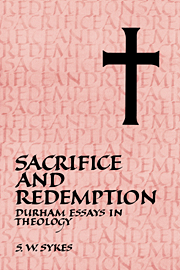Book contents
- Frontmatter
- Contents
- List of contributors
- Prefatory note
- Introduction
- PART I
- 1 Sacrifice and holiness
- 2 Sacrifice and world order: some observations on ben Sira's attitude to the temple service
- 3 Paul's understanding of the death of Jesus as sacrifice
- 4 Hebrews: the final sacrifice
- 5 St Athanasius on Christ's sacrifice
- 6 The doctrine of sacrifice: Augustine and the Latin patristic tradition
- 7 Sacrifice in the early East Syrian eucharistic tradition
- PART II
- PART III
- PART IV
- Index of biblical and ancient references
- Index of persons
7 - Sacrifice in the early East Syrian eucharistic tradition
Published online by Cambridge University Press: 10 March 2010
- Frontmatter
- Contents
- List of contributors
- Prefatory note
- Introduction
- PART I
- 1 Sacrifice and holiness
- 2 Sacrifice and world order: some observations on ben Sira's attitude to the temple service
- 3 Paul's understanding of the death of Jesus as sacrifice
- 4 Hebrews: the final sacrifice
- 5 St Athanasius on Christ's sacrifice
- 6 The doctrine of sacrifice: Augustine and the Latin patristic tradition
- 7 Sacrifice in the early East Syrian eucharistic tradition
- PART II
- PART III
- PART IV
- Index of biblical and ancient references
- Index of persons
Summary
The question of the relation of the concept of sacrifice to the eucharist has, as is well known, proved a divisive one in the West since the Reformation period, though happily there have been in recent years signs of the growth of a new understanding and synthesis. While the eucharist as such is not unambiguously termed a sacrifice within the New Testament, it is undeniable that this terminology appears early in the sub-apostolic age, though it is understood in a variety of ways by different patristic writers. A recent succinct but comprehensive review of patristic treatment of this subject to the early fourth century has been given by R. P. C. Hanson (1979) The earliest ideas are those of the ‘pure offering’ of the Christians, thought to have been predicted in Mai. I: II, consisting of the spiritual sacrifice of praise and thanksgiving and of the Christians’ self-offering to God, and the offering to God of the elements of bread and wine in the eucharist. These ideas are already fused by the time of Justin. Irenaeus adds the idea that the bread and wine are offered as the firstfruits of God's creation. The concept of the eucharist as an offering of Christ by the celebrant first appears in Cyprian. This appears to be the basis of the whole medieval development of Western eucharistic theology. Hanson's survey closes with the much more judicious statements of the doctrine made by Eusebius of Caesarea.
- Type
- Chapter
- Information
- Sacrifice and RedemptionDurham Essays in Theology, pp. 118 - 126Publisher: Cambridge University PressPrint publication year: 1991



